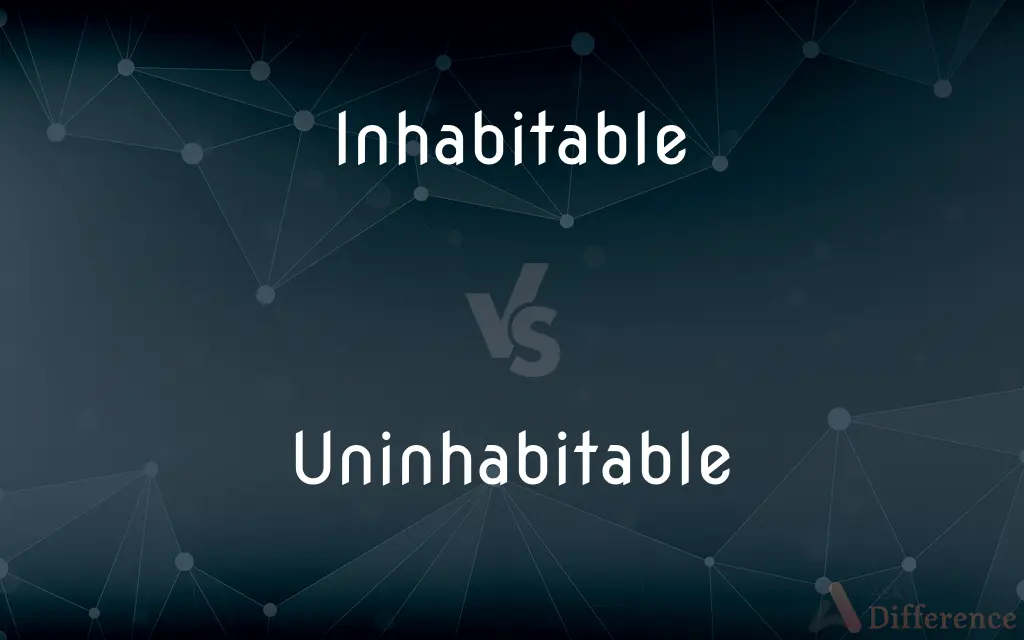Inhabitable vs. Uninhabitable — What's the Difference?
By Urooj Arif & Maham Liaqat — Updated on May 3, 2024
Inhabitable describes places suitable for living, whereas uninhabitable refers to areas where living conditions are impossible due to adverse circumstances.

Difference Between Inhabitable and Uninhabitable
Table of Contents
ADVERTISEMENT
Key Differences
Inhabitable areas are those that provide necessary conditions for human life, such as access to water, food, and shelter. Whereas, uninhabitable regions lack these essential supports, making survival for extended periods difficult or impossible.
Inhabitable environments typically boast moderate climates, fertile land, and available resources, promoting sustained human habitation. On the other hand, uninhabitable locations often feature extreme conditions like severe aridity, toxic pollution, or extreme cold, which are hostile to human settlement.
People often use the term inhabitable to describe homes or regions that are safe and comfortable for living. Uninhabitable areas, in contrast, are frequently marked by hazardous conditions or are damaged by disasters, rendering them unfit for habitation.
Urban planning and housing regulations also use these terms to classify areas or buildings. Inhabitable properties meet the criteria for safety, health, and welfare, whereas uninhabitable properties fail to meet these standards, often requiring significant renovation or are condemned.
In the context of real estate, an inhabitable property implies a ready-to-move-in condition with no major faults. Conversely, a property described as uninhabitable usually needs extensive repairs or is in a dilapidated state, impacting its value and desirability.
ADVERTISEMENT
Comparison Chart
Suitability for living
Suitable for living
Not suitable for living
Environmental conditions
Moderate and conducive to life
Extreme or hazardous conditions
Resource availability
Access to necessary resources
Lack of essential resources
Common usage
Safe and comfortable dwellings
Areas unfit due to hazards or damage
Real estate implications
Ready for occupancy; valued higher
Requires significant repair; valued lower
Compare with Definitions
Inhabitable
Capable of supporting life.
Scientists deem this planet inhabitable due to its earth-like conditions.
Uninhabitable
Not suitable for living.
The cabin is uninhabitable without major repairs.
Inhabitable
Suitable for living.
The island was found to be inhabitable despite its remote location.
Uninhabitable
Not fit for occupancy.
Post-flood conditions rendered many homes uninhabitable.
Inhabitable
Fit for occupancy.
The building was renovated to be inhabitable again after the earthquake.
Uninhabitable
Incapable of supporting life.
The extreme radiation makes the zone uninhabitable.
Inhabitable
Meeting the standards of habitation.
The apartment is inhabitable, with all utilities functioning properly.
Uninhabitable
Failing to meet habitation standards.
The house was condemned and labeled uninhabitable.
Inhabitable
Livable without restrictions.
After the cleanup, the area was declared inhabitable.
Uninhabitable
Livable with severe restrictions.
The polluted air quality in the area is nearing uninhabitable levels.
Inhabitable
To live or reside in
Dinosaurs inhabited the earth millions of years ago.
Uninhabitable
Unfit for habitation
An uninhabitable island.
Inhabitable
To be present in; fill
Old childhood memories inhabit the attic.
Uninhabitable
Not fit for people (or other living things) to live in; not able to be inhabited.
The earthquake left many homes in the area uninhabitable.
Inhabitable
To dwell.
Uninhabitable
Not fit for habitation
Inhabitable
Fit to live in; habitable.
Inhabitable
(obsolete) Not habitable; not suitable to be inhabited.
Inhabitable
Capable of being inhabited; habitable.
Systems of inhabitable planets.
Inhabitable
Not habitable; not suitable to be inhabited.
The frozen ridges of the AlpsOr other ground inhabitable.
Inhabitable
Fit for habitation;
The habitable world
Common Curiosities
What makes a place uninhabitable?
Extreme environmental conditions, lack of essential resources, or severe damage can render a place uninhabitable.
What is the difference between inhabitable and habitable?
There is no difference in meaning; both terms describe places suitable for living.
Can an uninhabitable place be made inhabitable?
Yes, through environmental management, resource provision, and infrastructural development, uninhabitable places can sometimes be restored.
What are examples of naturally uninhabitable places on Earth?
Deserts, high mountains, and areas near volcanic activity are naturally less suitable for human habitation.
Are there legal implications to declaring a property uninhabitable?
Yes, such declarations can affect property values, insurance rates, and legal occupancy permissions.
How do climate changes affect the habitability of a region?
Climate change can alter conditions, making previously habitable regions uninhabitable due to increased disasters or resource scarcity.
Can technology make uninhabitable places habitable?
Advanced technology in climate control and building engineering can make previously uninhabitable places suitable for living.
How do urban planners use the terms inhabitable and uninhabitable?
Urban planners use these terms to classify areas for development suitability and safety regulations.
What factors are considered when declaring a building uninhabitable?
Structural integrity, presence of hazardous materials, and lack of essential utilities are key factors.
How does government policy address uninhabitable conditions?
Governments may implement regulations and provide funding for restoration and prevention of uninhabitable conditions.
Share Your Discovery

Previous Comparison
Microcomputer vs. Supercomputer
Next Comparison
Personalisation vs. PersonalizationAuthor Spotlight
Written by
Urooj ArifUrooj is a skilled content writer at Ask Difference, known for her exceptional ability to simplify complex topics into engaging and informative content. With a passion for research and a flair for clear, concise writing, she consistently delivers articles that resonate with our diverse audience.
Co-written by
Maham Liaqat















































